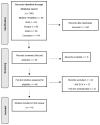Effects of Virtual Reality on Adults Diagnosed with Chronic Non-Specific Low Back Pain: A Systematic Review
- PMID: 40508940
- PMCID: PMC12155277
- DOI: 10.3390/healthcare13111328
Effects of Virtual Reality on Adults Diagnosed with Chronic Non-Specific Low Back Pain: A Systematic Review
Abstract
Background/objectives: Non-specific low back pain represents a high number of primary care consultations, generating a great social and economic cost. There is a higher prevalence in women, and it may be associated with multiple factors. One of the most innovative tools in rehabilitation is virtual reality-based therapy. Virtual reality positively affects the motivation of participants and generates greater adherence to treatment, so this factor could lead to long-term functional improvement. The objective of this review is to update the effectiveness of virtual reality programs on pain, disability, kinesiophobia, and changes in the thoracoabdominal musculature in patients with chronic nonspecific low back pain.
Methodology: PubMed, PEDro, SCOPUS, Web of Science, and the Cochrane Library were used in this systematic review. The research question was formulated using PICOS. The Physiotherapy Evidence Database (PEDro) scale was used. Inclusion criteria were randomized clinical trials, participants were men and/or women over 18 years of age who were diagnosed with chronic non-specific low back pain, and articles that included virtual reality as a treatment. Articles with a level of evidence lower than 5/10 on the PEDro scale were excluded.
Results: A total of 14 studies were included with sample sizes between 34 and 188 participants. Studies showed significant improvements in pain reduction, kinesiophobia, and disability (inflammation and motor control). Some studies showed long-term benefits, with effects maintained up to 18 months post-intervention, especially in the reduction in pain and its interference with daily activities.
Conclusions: The findings of this systematic review support the efficacy of virtual reality as an effective and safe therapeutic option for the treatment of chronic non-specific low back pain.
Keywords: chronic low back pain; exercise; low back pain; rehabilitation; virtual reality.
Conflict of interest statement
The authors declare no conflicts of interest.
Similar articles
-
Folic acid supplementation and malaria susceptibility and severity among people taking antifolate antimalarial drugs in endemic areas.Cochrane Database Syst Rev. 2022 Feb 1;2(2022):CD014217. doi: 10.1002/14651858.CD014217. Cochrane Database Syst Rev. 2022. PMID: 36321557 Free PMC article.
-
Virtual reality-based therapy for chronic low back and neck pain: a systematic review with meta-analysis.EFORT Open Rev. 2024 Jul 1;9(7):685-699. doi: 10.1530/EOR-23-0197. EFORT Open Rev. 2024. PMID: 38949175 Free PMC article.
-
Efficacy of Sensor-Based Training Using Exergaming or Virtual Reality in Patients with Chronic Low Back Pain: A Systematic Review.Sensors (Basel). 2024 Sep 27;24(19):6269. doi: 10.3390/s24196269. Sensors (Basel). 2024. PMID: 39409307 Free PMC article.
-
Does McKenzie therapy improve outcomes for back pain?J Athl Train. 2006 Jan-Mar;41(1):117-9. J Athl Train. 2006. PMID: 16619104 Free PMC article.
-
Autologous growth factor injections in chronic tendinopathy.J Athl Train. 2014 May-Jun;49(3):428-30. doi: 10.4085/1062-6050-49.3.06. Epub 2014 May 19. J Athl Train. 2014. PMID: 24840581 Free PMC article.
References
-
- Palacios-Ceña D., Alonso-Blanco C., Hernández-Barrera V., Carrasco-Garrido P., Jiménez-García R., Fernández-de-las-Peñas C. Prevalence of neck and low back pain in community-dwelling adults in Spain: An updated population-based national study (2009/10–2011/12) Eur. Spine J. 2015;24:482–492. doi: 10.1007/s00586-014-3567-5. - DOI - PubMed
-
- Peña A., Gestoso M., Kovacs F., Mufraggi N. Escuela Española de la Espalda: Prevención y rehabilitación de las patologías mecánicas del raquis. Med. Fam.-SEMERGEN. 1997;5:16–22.
Publication types
LinkOut - more resources
Full Text Sources


